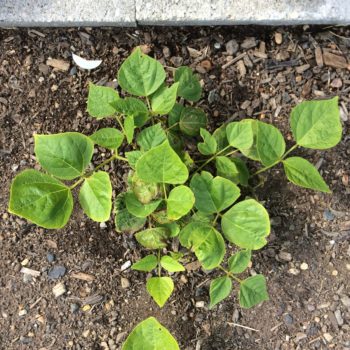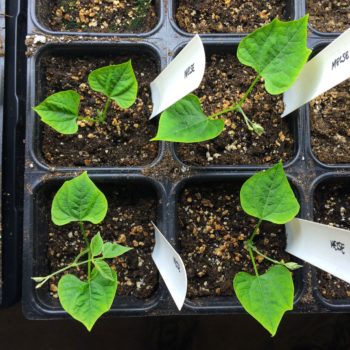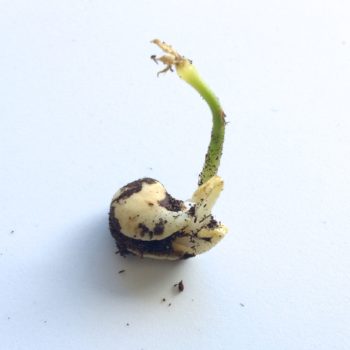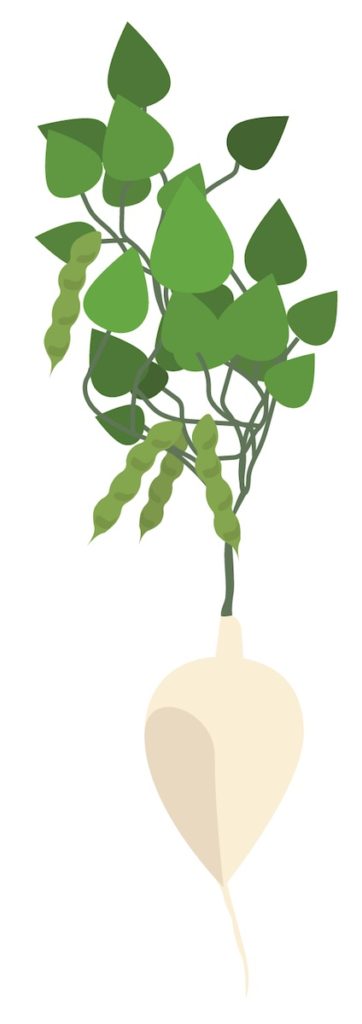No products in the cart.
Ahipa (Pachyrhizus ahipa)
| I am no longer actively breeding or growing ahipa. There are more crops in the growing guide that I have stopped growing than that I continue to grow. There are many reasons why I stop growing a plant. Often the available genetic diversity isn’t sufficient, the crop does not perform well in my climate, or I just find that I don’t enjoy or make much progress breeding it. Sometimes I come back to a plant later, but you should assume that this crop will not be offered in the store in the foreseeable future. |
Overview
- Ahipa (Pachyrhizus ahipa) is a root crop native to the lower elevations of the Bolivian Andes and closely related to jicama.
- Ahipa is a rare crop, in danger of extinction or critical loss of genetic diversity.
- This crop is challenging to grow in the Pacific Northwest and very difficult in much of the rest of the US.
- The white/tan root can reach about eight inches in length and more than a pound.
- Flavor is similar to jicama – crisp and slightly sweet. Is can be eaten raw or cooked.
- Ahipa requires a very long growing season that is neither too hot nor too cold in order to set seed.
- The crop is propagated primarily by seed. The roots can be replanted, but generally only one root is produced per plant.
About Ahipa
Description
Ahipa (also ajipa; Pachyrhizus ahipa), pronounced ah-HEE-pa, is a tuber forming legume in the family Fabaceae, along with garden beans, peas, broad beans, hopniss, and many other edibles. It is closely related to jicama (Pachyrhizus erosus), a similar plant found in Central America. While jicama is a plant of warm climates, ahipa is a plant of, well, slightly less warm climates. In fact, it is a bit of a Goldilocks plant, preferring temperatures that are neither too warm nor too cold. Ahipa, jicama, and other members of the genus Pachyrhizus are collectively known as “yam beans,” a fairly apt description, since they are bean plants that form edible storage roots. They have no close, botanical relationship to yams though.

The above ground portion of the plant is recognizably bean like, while underground it forms a fairly large storage root, weighing up to 1.5 pounds (680 g), although I typically consider a half pound (227 g) to be a very good result here. The root is somewhat similar to yacon, being crisp and slightly sweet, but more starchy. As with yacon, it is traditionally used more like a fruit than a vegetable.
Approximately twenty varieties are known (Sorenson 1996) but some of them may only exist in germplasm collections at this point. There are both vining and bush forms of ahipa, but only bush forms are widely available outside the Andes. The bush forms reach about twenty inches (50 cm) in height and breadth. The vining forms are indeterminate and may reach several meters in length (Hermann 1997). Most varieties produce a single storage root, but there are a few that produce multiple roots. Unfortunately, only single rooted varieties appear to be available outside the Andes. Seed and root yields vary substantially among the varieties that have been characterized. As a legume, it has the convenient feature of fixing nitrogen. Some varieties produce different colored seeds, but the majority are predominantly black (Hermann 1997).
Ahipa joins mauka in the dubious distinction of being among the least cultivated domesticated crops in the world. It may be in danger of extinction if its use declines much further. A wild form has not been discovered yet and the species may exist only in cultivation.
There appear to be only two widely available varieties, both of which are fairly similar bush types. This is really unfortunate, since this is a crop that could perform well in much of the United States and would benefit greatly from the preservation efforts of amateur seed saving networks.
History
No wild forms of ahipa are known and evidence exists for human use in the Andes for at least 2,000 years (NRC 1989). These facts suggest that ahipa may be one of the older Andean crops, or perhaps that the wild plant was never widely distributed.
According to Sorensen (1996), the greatest degree of diversity is found in Bolivia, which is probably its region of origin. A few varieties are found also in Argentina, although they may be critically endangered and perhaps even absent from cultivation by now. In the Andes today, what little ahipa is produced is for home consumption; there is no commercial ahipa crop.
In 1985, the Yam Bean Project collected, distributed, and studied the several Pachyrhizus species. Much of the available information about ahipa was produced as part of that project. Unfortunately, as is so often the case, the project ended and it appears that little of the material is still grown now, thirty years later.
Nutrition
Little is published about the nutritional qualities of ahipa, but it is probably similar to its close relative jicama. If it is similar, then it would be low in calories and rich in potassium and vitamin C (NRC 1989). The storage root is relatively high in protein for a root crop and contains significant amounts of starch and sugars (Hermann 1997).
The foliage and especially the seeds and seed pods contain the pesticide rotenone and should not be eaten. Only the root of ahipa is traditionally consumed.
Cooking and Eating
Ahipa is usually eaten raw, like a fruit. I think this is its most appealing preparation, but it can also be baked, boiled, or fried, after which it takes on a starchier aspect.
Morphological Characteristics
Morphological characteristics that vary between varieties are useful for identification and provide a starting point for breeding efforts.
Plant Form
Three plant forms are recognized:
- Bush form: Erect, determinate growth with a height of six to sixteen inches (15 to 40 cm).
- Sprawling bush: Semi-erect with a height/length of 12 to 24 inches (30 to 60 cm).
- Twining: Climbing, indeterminate growth with a height of 24 to 80 inches (60 to 200 cm).
Number of Tubers
Two forms are recognized:
- Monotuberous: A single, large tuber.
- Multituberous: A large central tuber with additional small side tubers.
Cultivation
Climate Tolerance
In its native region, ahipa experiences average temperatures in the sixties F (15 to 21 C), but temperatures may range from near freezing to the low nineties (32 to 35 C) during the growing season. Ahipa appears to be comfortable under roughly the same conditions as runner beans. It doesn’t like to be too hot nor too cold. Temperatures above 90° F (32 C) cause it to wilt. Temperatures below 50° F (10 C) result in extremely slow growth. In the Pacific Northwest, it grows slowly in spring, when the temperatures don’t reach its preferred range.
Ahipa requires only moderate water, similar to garden beans. It cannot survive a frost, although it will sprout from the root if frosted after it has had a chance to develop. It should be grown in full sun in all but very hot climates, where it may benefit from some afternoon shade.
In the Pacific Northwest, ahipa performs best in warm, humid areas, such as the Willamette Valley. It also does well east of the Cascades where the climate is not too scorching in the summer. In western Washington, the Oregon coast, and the north coast of California, ahipa may require plastic mulch or a low tunnel in order to increase spring and fall temperatures to ensure good development.
Ahipa is also worth a try in the Southeast and parts of the Midwest that don’t have very short growing seasons. It may be possible to grow ahipa over the winter in frost free parts of California and in the South.
Photoperiod
Ahipa has no photoperiod dependency for tuber formation and supposedly none for flowering, but we have several varieties that have never flowered before late September. This could just be a coincidence, indicative of a long time to maturity before flowering.
Soil Requirements
Ahipa tolerates very acidic to neutral soil. It is nitrogen fixing with the help of the proper strain of bacteria, but in its absence, ahipa benefits from a balanced organic fertilizer. Soil should drain freely, as the quality of the storage root is poor in wet soil.
Inoculation with the proper strain of Rhizobium bacteria nearly doubled root yield in one study (Leidi 2004). Unfortunately, the strain was not specified and does not appear to be readily available. I have not found root nodules after inoculation with readily available bean or broad bean inoculants or by inoculating with scrapings from the surface of jicama (Pachyrhizus erosus) purchased at the grocery store.
Propagule Care
Seeds of ahipa appear to have good storage life, retaining high germination after five years in my experience. In tropical areas, seed is reported to retain good germination for only three or four years (NRC 1989), so cool, dry temperatures are probably important for long term storage. I store ahipa seeds at about 50° F (10 C).
Planting

In a sufficiently warm climate, ahipa will complete its life cycle in seven to nine months, leaving behind a harvestable storage root and fully dried aerial plant (Leonel 2005).
In the Andes, planting distances range widely, from 2.5 to 10 inches (6 to 25 cm) in row and 8 to 24 inches (20 to 60 cm) between rows (Sorenson 1996). Closer planting results in smaller roots, but also typically greater aggregate yields.
Sow ahipa as you would garden beans. You can direct sow ahipa when the soil temperature rises to at least 55° F (12 C), although 65° F is better if it doesn’t require too long a wait. They also transplant well and can be started quickly indoors at a temperature of 70° F (21 C).
Ahipa can theoretically be started at any time of year when there is enough frost free growing season remaining. Here, that gives us the option of planting at any time of year, as long as it is April. Your climate may be more flexible. In cool summer climates like the Pacific Northwest, the best strategy seems to be starting ahipa indoors in 2 liter mesh grow bags and then planting those grow bags out once the soil temperature reaches about 60° F. This allows the plants to develop more quickly, but also minimizes transplant injury, to which ahipa seems very susceptible.
Ahipa relies on a species of rhizobacterium in order to fix nitrogen. Unfortunately, the proper strain doesn’t appear to be available in the US. Because of this, it is best to give ahipa a supplemental source of nitrogen. Seedlings are otherwise slow to put on growth and tend to be yellow and sickly. They do eventually put on enough root growth to overcome this, but you can give the plants a big boost by supplying a hefty does of nitrogen rich fertilizer.
Management
Reproductive pruning is required in order to achieve good storage root yields with most varieties. There are two strategies used by Andean growers: leaving the first few pods on each plant before pruning any further flowers or allowing only the most promising looking plants to fully flower and set seed (Sorenson 1996). Unless you are growing a lot of plants, I recommend the first strategy, as it increases the odds that you will be able to collect mature seed from at least some of the plants.
Reproductive pruning typically entails removing all flowers from the plant at least every thirty days (Leonel 2005). Leidi (2004) found that roots were two to five times larger with reproductive pruning than without, in all but one variety. Left alone, ahipa will form many seed pods and the energy that it requires for this task will be diverted from the storage root.
Companion Planting
Ahipa doesn’t seem particularly promising for companion planting. It really needs full sun and it is a fairly small plant that can be easily overpowered by stronger or larger companions. Vining types might be more suitable for mixed planting, but I’ve never seen one.
Growing as a Perennial

Ahipa is a perennial plant, but the benefits of growing it as such are not obvious. It can be grown for multiple years in order to maximize seed production, but the quality of the root for eating is poor after the first year. As a nitrogen fixer, it could potentially be used as a long term cover crop. For that to become an attractive proposition, a source of the proper strain of symbiotic nitrogen fixing bacteria will have to be identified.
Container Growing
Ahipa makes a pretty good container plant. In fact, it is the only Andean root crop that I routinely grow in containers. A five gallon pot or bucket suits it fine and can accommodate two plants with regular watering. The additional soil warming seems to be advantageous.
Harvest
Ahipa will grow to full size in about six months in a warm climate. In cool summer climates, it struggles to produce a worthwhile root in nine months. In the Andes, the storage root may reach two to three pounds (about a kilogram). In the Pacific Northwest, a half pound (227 g) root is a very good result.
The root has a tendency to crack if watered heavily in the last month before harvest. Withhold water if you can. In the Pacific Northwest, late summer rains tend to arrive at just the wrong time. This is where you will find an advantage in growing plants in containers, since they can be moved under cover when wet weather arrives.
Storage
Ahipa roots store reasonably well at a temperature of about 50° F (10 C) and 90% humidity. Temperatures much warmer or much cooler than that dramatically reduce storage life. I have stored ahipa for as much as two months at 50° F without loss of quality. After two months, the texture begins to change, quality declines rapidly, and sprouting may begin. At this stage, any roots that will be grown for seed production should be potted. Ahipa can also be stored in the ground (NRC 1989) and this will probably prove to be the best practice in climates where soil freezing is not a problem.
Storage alters the starch sugar balance in ahipa roots (Sorenson 1996). This is usually desirable because it produces a sweeter root. Ahipa also can be sweetened significantly by exposure to sunlight.
Preservation
No information is available regarding traditional means of preservation. Ahipa probably won’t can particularly well, although it might dry if sliced thinly. Pickling smaller roots could be interesting, but I haven’t tried it.
Propagation
Unlike most of the Andean root crops, ahipa is almost always grown from seed. It can be propagated from cuttings or side tubers for specialized needs.
Vegetative Propagation
The plant may be propagated from stem cuttings. This is not a traditional method, but may be useful for breeding work or to multiply varieties for which little seed is available. Cut six inches (15 cm) from the end of a stem and put the bottom two inches (5 cm) in wet soil. Cover with a humidity tent. Rooting takes six to eight weeks, so the best practice is to take cuttings in late summer and root them for overwintering in a greenhouse.
Varieties that form multiple tubers can be propagated from the smaller side tubers, but I have no experience with this. If you are lucky enough to have some, they should probably be potted for winter storage, as this is the most conservative approach.
Sexual Propagation

Like most legumes, ahipa is primarily self pollinating. Pods will form without human or insect intervention, each containing multiple seeds. The seed pods require either a warm summer or a long growing season in order to mature.
Seed saving is complicated by the need for reproductive pruning in order to produce good sized roots. Because the size and quality of the storage root cannot be evaluated while the plant is growing, it is probably a good idea to save a little seed from all of the plants, rather than a lot of seed from just a few. The roots can then be evaluated following harvest and seeds from only the best plants retained. Because it is a perennial, you can also carry over roots from year to year, which will provide a big head start in seed production. In our climate, biennial seed production is much more reliable. Employing total reproductive pruning in the first year and then allowing the plants to fully flower in the second year may be the best strategy for seed production in cool summer climates.
Pollen fertility is relatively low in some varieties, but almost always greater than 50% (Hermann 1997), which does not create a significant impediment to breeding work. Pollinators are probably not required for ahipa, since the flowers self pollinate, but I have observed plenty of insect interest in the flowers, particularly by bumble bees.
As with most beans, the seeds are ready for storage when they cannot be dented with a fingernail. You should also store them with a desiccant to ensure that they are sufficiently dry.
Problems
Pests
No problems with pests have been reported, but before you take that too optimistically, this is probably partly a consequence of the extremely small amount in cultivation. It may also reflect the fact that the plants contain rotenone, which acts as a pesticide. Slugs are not affected by rotenone and will happily chew your ahipa plants down to stumps if given the opportunity.
Voles, the arch enemy of most plants in this book, will also happily eat your ahipa roots, although they will generally leave the seed pods untouched.
Diseases
Very little is published about diseases of ahipa. It should probably be assumed that it is vulnerable to generalist pathogens that target garden beans and peas.
Defects
Ahipa often suffers from yellowing, particularly early in the growing season. This may be partly a response to low temperature, but the most likely cause would seem to be the lack of symbiotic nitrogen fixing bacteria. The situation improves as the plant becomes established. It can be corrected temporarily with a foliar application of fish emulsion.
Crop Development
Absolutely any development of ahipa would be a step in the right direction. This is a promising crop that could do well in many parts of North America. The most obvious direction would be breeding for faster cropping. Although the plant grows well, the long time that it takes to mature its storage root can push harvest into a less convenient time of the year. Likewise, breeding for better performance in slightly cooler climates could also expand its potential growing area.
Breeding for multiple tubers, especially for use as propagation material would increase its appeal as a permaculture plant. A nitrogen fixing plant that can be left in the ground for multiple years while harvesting secondary tubers would be quite appealing.
Breeding for varieties that either produce a smaller number of flowers (dangerous) or that produce a good root yield without reproductive pruning would make the crop more accessible to large scale production.
Hybrids between ahipa and jicama have been produced. They may both increase yield and performance in warmer climates, although the greater value may be in transmitting ahipa’s lack of photoperiodism to jicama (NRC 1989). Jicama could introduce characteristics like vining habit to ahipa.


Good morning,
very interesting article indeed!
Could you please tell me where I can find seeds of P. ahipa? I would like to try and grow it.
Kind regards
Silvio
It is possible that I will have some in the fall. It is a pretty difficult crop to get seed from here. I get a crop of seed large enough to sell about one year in three.
Hello,
I am interested in growing Ahipa, will you have some in the future?
Thank you for your time,
Shayne
I will probably have it again, but not this year. It is one of the more difficult Andean crops to grow here and I haven’t really made any progress with it.